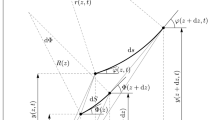Abstract
If a mechanical system moves from a configurationx 0 to another configurationx, the work of all the forces, corresponding to all kinematically admissible paths and all speeds of description of those paths, usually is bounded above. It then possesses a least upper bound −Λ(x 0,x). If the system is conservative, Λ(x 0,x) is the inerement of potential energy. However, conservatism is not assumed. The function Λ(x 0,x) plays the role usually given to potential energy in stability theory. This generalization is illustrated with two different dynamical criteria for static stability. Properties of the function Λ(x 0,x) that ensure stable equilibrium at pointx 0 are derived from the law of kinetic energy in the context of geometry of configuration space.
Résumé
Si un système mécanique se déplace d'une configurationx 0 vers une autre configurationx, le travail de toutes les forces, correspondant à tous les chemins admissibles de façon cinématique et à toutes les vitesses de description de ces chemins, est d'habitude limité d'en haut. Le travail possède alors une moindre limite supérieure −Λ(x 0,x). Si le systéme est conservatif, Λ(x 0,x) est l'incrément de l'énergie potentielle. Toutefois, le conservatisme n'est pas supposé. La fonction Λ(x 0,x) joue le rôle qui est d'habitude attribué à l'énergie potentielle dans la théorie de la stabilité. Cette généralisation est illustrée avec deux critériums dynamiques pour la stabilité statique. Les propriétés de la fonction Λ(x 0,x) qui assurent l'équilibre stable au pointx 0 se dérivent de la loi de l'énergie cinétique dans le contexte de géométrie de l'espace de configuration.
Similar content being viewed by others
References
S. Banach,Mechanics, Lwów (1938); English transl. by E. J. Scott. Warsaw (1951), p. 119.
H. Zifgler,Linear Elastic Stability, Z. angew. Math. Phys.4, 167–184 (1953).
R. Shield andA. E. Green,On Certain Methods in the Stability Theory of Continuous Systems, Arch. Rat. Mech. Anal.12, 4, 354–360 (1963).
H. Ziegler,Die Stabilitatskriterien der Elastomechanik, Ing. Arch.20, 49–56 (1952).
F. R. Shanley,Inelastic Column Theory, J. Aero. Sci.14, 5, 261–268 (1947).
D. C. Drucker andE. T. Onat,On the Concept of Stability of Inelastic Systems, J. Aero. Sci.21, 8, 543–549 (1954).
R. L. Jeffery,The Theory of Functions of a Real Variable, 2nd ed, Univ. of Toronto Press, Toronto (1953), Chapt. 2.
F. Hausdorff,Mengenlehre, Dover Publ., New York (1953), Chapt. 6.
C. Lanczos,The Variational Principles of Mechanics, Univ. of Toronto Press, Toronto (1949), 86–87.
J. Pierpont,The Theory of Functions of Real Variables, vol. 1, Ginn & Co., New York (1905).
Author information
Authors and Affiliations
Rights and permissions
About this article
Cite this article
Langhaar, H.L. Geometry and stability theory. Journal of Applied Mathematics and Physics (ZAMP) 29, 549–560 (1978). https://doi.org/10.1007/BF01601484
Received:
Issue Date:
DOI: https://doi.org/10.1007/BF01601484




